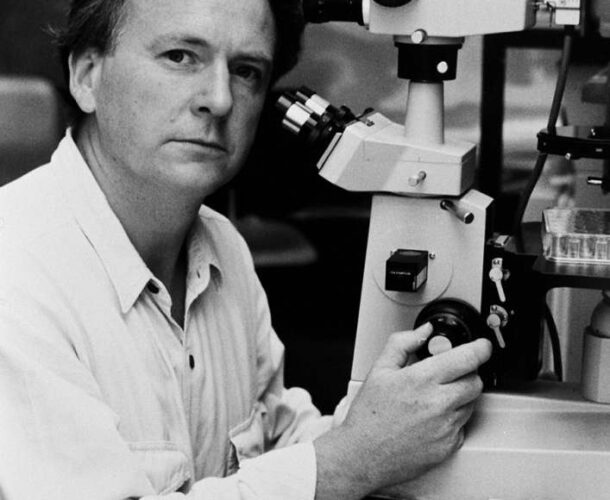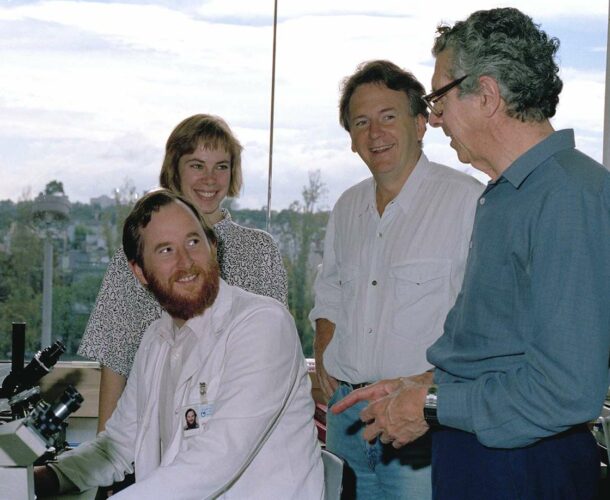Professor Perry Bartlett and colleagues go on to discover the existence of stem cells in the brain that can produce new neurons, providing new hope for patients with brain injuries and degenerative conditions such as Alzheimer’s disease.
Perry Bartlett, immunologist and neurologist
The plan was to become a dentist. But by the time he graduated, Perry Bartlett had been captivated by another prospect – medical research.
It was while he was pursuing a PhD in immunology that he became increasingly aware of the work going on across the road at the Walter and Eliza Hall Institute, and Bartlett began to aspire to one day “being part of that wonderful machine, with Jacques Miller and Gus Nossal, and of course [Macfarlane] Burnet was still around as well”.
Connecting immunology and neuroscience
After finishing his PhD in 1975, Bartlett headed to Johns Hopkins University in the US, spending four years focusing mainly on cell biology and MHC (major histocompatibility complex) molecules, major players in the immune system.
From there he headed to University College London, where he followed the lead of Professor Martin Raff and switched from immunology to the evolving area of neurobiology.
“In those days we didn’t have any way of identifying different types of brain cells, so we made the first monoclonal antibodies that identified subsets of nerve cells in the brain,” Bartlett explains. “That was my start in neuroscience, which had an immunological flavour to it.”
Establishing a new field of research
Wondering whether it might be time to head home, he wrote to Gus Nossal. “If I was going to come back, the Hall Institute was the only place I’d come back to.”
The result was that in 1978 Bartlett set up the world’s first neuro-immunology laboratory at the Walter and Eliza Hall Institute. It was a bold experiment, “and Gus was an enormously generous supporter”.
One of its major discoveries upset the long-held view that MHC molecules were not found in the brain, and that as a consequence it was a kind of immune-response free zone. “We found that these molecules could be expressed in there when there were inflammatory processes going on.”
Bartlett became increasingly preoccupied with exploring basic neuroscience, trying to understand the different types of cells, at the development of the brain, and investigating the stem cells that give rise to all the neurones.
Providing new hope for patients with brain injuries
“I thought ‘well, if there are these stem cells developmentally, where do they go? Do they just turn off? Or is it possible that even in the adult brain we have some of these cells that might be able to make new neurones’. In those days the idea of brains having the capacity to make new nerve cells was thought to be impossible – all you did was lose cells with age, not gain them.”
In 1992, 10 years of investigation culminated in a blockbuster paper demonstrating that the adult brain did have the capacity to produce new neurons (nerve cells), a finding cracking open potential and hope for people with brain injuries or degenerative conditions such as dementia and Alzheimer’s disease. The finding coincided with a similar one published independently by a group in Canada.
“At the time there was a lot of scepticism,” Bartlett recalls. Nossal, in his book Diversity and Discovery, describes the response as a “furore – so much so that I asked a member of Don Metcalf’s group to confirm the findings, which he did”.
The next question, Bartlett said, was to determine whether this capacity had any meaningful role in the brain, or whether it was just a remnant of development. “And that set the pattern for the next 20 years of my life, working out what these new nerve cells do, whether they are important. And I’m still working on it.”
Redefining the brain
In 2001 his curiosity yielded another epic paper, featured on the cover of Nature, in which Bartlett’s group from the institute isolated and characterised brain stem cells.
“The really big finding was that the brain wasn’t this stagnant organ, but had the capacity to make new nerve cells, and we identified those and have subsequently been able to show they are pretty important to normal function, and are able to be a source of regeneration to reverse the decline of cognition” – at least in animals, and now, further research is finding, in humans.
Bartlett has another paper pending publication – with all the makings of another blockbuster – “showing that we can reverse cognitive decline in old mice by activating the production of new nerve cells.
“We’ve found there is a sweet spot in exercise, and if you exercise enough – but not too much – that corresponds to a certain change in the brain’s biochemistry.”
After the institute
Bartlett went to Brisbane in 2003 to head the new Queensland Brain Institute, at the University of Queensland, one of a cohort of institute alumni who migrated north to play key roles in the evolution of that state’s now heavy-hitting medical research and biotechnology sector. It was the proverbial offer too good to refuse, a chance to build a dedicated neuroscience institute from the ground up. Today it has 500 people.
While he’s been gone from the Walter and Eliza Hall Institute for 13 years, his work and that of his new group are deeply grounded in the thinking, techniques and commitment to long-haul investigation forged in Melbourne.
“That’s why the WEHI was such a good place for me – that whole concept of stem cells and lineages and regulation of stem cells. What I was doing was the neuroscience equivalent of the Metcalf work on the haemopoietic (blood) system.
“Science is driven by ideas. Most neuroscientists weren’t thinking this way … so the whole sense of how lineages worked and how stem cells were important was imbued in the Hall Institute. I probably wouldn’t have done that work elsewhere.
“It’s a very reductionist approach, but one looking at the fundamental processes that regulate the production of nerve cells that start developmentally, and saying ‘why the hell shouldn’t this happen in the adult?”
As with Metcalf’s epic laboratory journey, Bartlett’s work pursues a long, painstaking narrative, following his nose to the next question, and the next. “By the time you finish it’s like ‘well, that was obvious!’.
“It’s always like that in science. No-one believes you at first, then people start thinking ‘well, there is something to it’. And then ‘well, you know, it was bloody obvious there would be cells there’.” But that, he observes, is science.
Enduring institute influences
Bartlett’s experience at the institute was formative in other ways. Not least was working with Professor Jacques Miller on some questions around multiple sclerosis. “He was my hero, to tell you the truth, and remains that way – a polymath, one of the truly great scientists of our age.”
And when it came to stepping up to run a major medical research institution himself, Bartlett borrowed heavily from Nossal’s style, which he discovered he had picked up “by osmosis … I learned so much from him, especially in terms of how to handle a large number of people, as I have had to do here.
“You can only learn at the feet of the master. And he’s a master because he’s not terribly hands on, not prescriptive, but gently guides and facilitates and helps people reach their goal. You get great people, you give them the resources they need, and you let them go.
“Stars are created. They don’t necessarily make it unless you have someone who is going to assist them. And the Hall Institute is pretty good at creating stars.”





